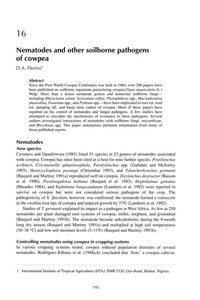Welcome to the International Institute of Tropical Agriculture Research Repository
Nematodes and other soilborne pathogens of cowpea
| dc.contributor.author | Florini, D. |
| dc.date.accessioned | 2019-12-04T11:22:01Z |
| dc.date.available | 2019-12-04T11:22:01Z |
| dc.date.issued | 1997 |
| dc.identifier.uri | https://hdl.handle.net/20.500.12478/3925 |
| dc.description.abstract | Since the First World Cowpea Conference was held in 1984, over 200 papers have been published on soilborne organisms parasitizing eowpea.V/o/za unguiculata (L.) Walp. More than a dozen nematode genera and numerous soilborne fungi including Rhizoctonia solanL cleroriitm rotfsii, Phytophthora spp., Macrophonrina phaseoliiw, Fusarhtm spp., and Pyihium spp.—have been implicated in root rot, seed rot, damping off. and basal stem canker of cowpea. Most of these papers have reported on the control of nematodes and fungal pathogens. A few studies have attempted to elucidate the mechanisms of resistance to these pathogens. Several authors investigated interactions of nematodes with soilborne fungi, mycorrhizae, and Rhizobium spp. This paper summarizes pertinent information from many of those published reports. |
| dc.language.iso | en |
| dc.subject | Nematodes |
| dc.subject | Pathogens |
| dc.subject | Pratylenchus Sefaensis |
| dc.subject | Population Densities |
| dc.subject | Cowpea Cultivar |
| dc.title | Nematodes and other soilborne pathogens of cowpea |
| dc.type | Book Chapter |
| cg.contributor.crp | Grain Legumes |
| cg.contributor.affiliation | International Institute of Tropical Agriculture |
| cg.coverage.region | Africa |
| cg.coverage.region | West Africa |
| cg.coverage.country | Nigeria |
| cg.authorship.types | CGIAR single centre |
| cg.iitasubject | Pests Of Plants |
| cg.iitasubject | Plant Breeding |
| cg.iitasubject | Cowpea |
| cg.iitasubject | Plant Diseases |
| cg.iitasubject | Disease Control |
| cg.iitasubject | Plant Ecology |
| cg.iitasubject | Plant Genetic Resources |
| cg.iitasubject | Plant Health |
| cg.iitasubject | Plant Production |
| cg.iitasubject | Farm Management |
| cg.accessibilitystatus | Open Access |
| local.dspaceid | 99211 |

